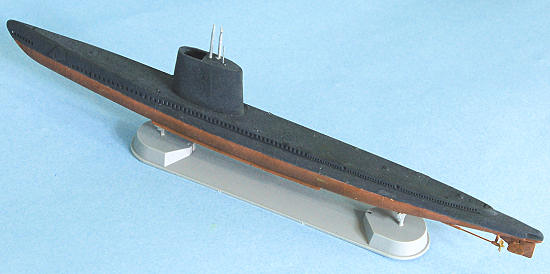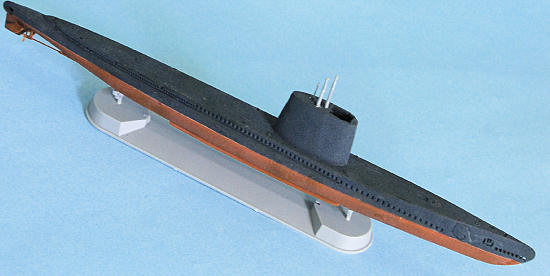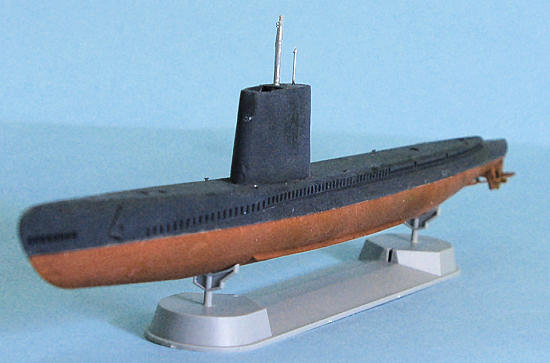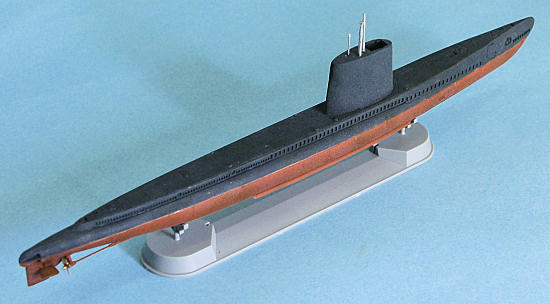
AFV Club 1/350 Guppy II
| KIT #: | - |
| PRICE: | $ |
| DECALS: | - |
| REVIEWER: | Tom Cleaver |
| NOTES: |
Conversion.
Kit modified with scratchbuilt “northern sail” |

| HISTORY |
The GUPPY Submarine:
The major technological advance in diesel-electric
submarines was the development of the snorkel, which allowed the operation of
the diesel engines at periscope depth, and the development of the Type XXI
U-boat by the Germans, the first submarine designed for greater performance
underwater than on the surface. The snorkel was widely adopted by the navies of
the world and improved after the war, while the Type XXI submarine
revolutionized submarine design in all navies.
The US Navy designed the “Tang” class to take advantage
of everything learned from the Type XXI U-boat, the new boats were so much
better they made the existing fleet boat obsolete, but these were too expensive
in the post-war period to produce enough of them to satisfy all the needs for
submarines.
In 1949, the Navy began the Greater Underwater
Propulsive Power Program, for which the acronym GUPPY was created by dropping
the lat “P” to convert and backfit existing late-production “Gato” and “Balao”
class fleet submarines with many of the German Type XXI submarine design
features. Deck guns and anti-aircraft armament were removed, the outer hull was
streamlined, the conning tower replaced by a streamlined sail, larger propellers
were fitted, more air conditioning was installed for the greater heat generated
by the electric motors, and the battery capacity doubled. The end result was
submarines which were capable of 18.2 knots submerged, equaling the Type XXI,
and exceeding their surfaced speed by 0.4 knots.
 The GUPPY program included three major phases. Guppy I,
which was essentially experimental, involved only two boats,
Odax (SS‑484) and Pomodon
(SS‑486), which both became part of the main program, and led to the GUPPY IA
The GUPPY program included three major phases. Guppy I,
which was essentially experimental, involved only two boats,
Odax (SS‑484) and Pomodon
(SS‑486), which both became part of the main program, and led to the GUPPY IA
These boats were
"rode hard."
In the
Most information about the operations of GUPPY
submarines during the Cold War remains classified to this day.
Without converting the fleet boats of World War II to
the GUPPYs of the Cold War era, the success of submarine cold war operations
would not have been possible.
These submarines "held the Line" until the SSNs and
SSBNs took over.
USS BLACKFIN (SS-322):
 The Balao class
USS Blackfin (SS‑322) was launched
March 12, 1944 at Electric Boat Co. in Groton, Connecticut and commissioned July
1944.
She arrived at Pearl Harbor on September 11, 1944, and undertook five
war patrols in the South China Sea and Yellow Sea.
She sank the Japanese destroyer
Shigure and a cargo ship on January 24, 1945, her only
victories during the war.
The Balao class
USS Blackfin (SS‑322) was launched
March 12, 1944 at Electric Boat Co. in Groton, Connecticut and commissioned July
1944.
She arrived at Pearl Harbor on September 11, 1944, and undertook five
war patrols in the South China Sea and Yellow Sea.
She sank the Japanese destroyer
Shigure and a cargo ship on January 24, 1945, her only
victories during the war.
In November 1950 Blackfin
began conversion to a GUPPY submarine, being recommissioned on May 15, 1951. She
spent her career until retirement with Submarine Force, Pacific Fleet, based at
San Diego.
During her career, Blackfin
was used in two movies: “Move Over, Darling” in 1963 starring Doris Day, James
Garner, and Polly Bergen, and “Ice Station Zebra” in 1968, starring Rock Hudson,
Ernest Borgnine, and Patrick McGoohan, during which filming she operated on
battery power surfaced to simulate a nuclear boat.
Your reviewer had the opportunity to go to sea aboard
Blackfin during the 1964 SEATO
exercises for two days of submarine familiarization, as the guest of an old high
school friend who was a crew member (which is why this model is
Blackfin and not some other boat).
Blackfin operated in the Gulf of
Tonkin on several patrols during the Vietnam War, all of which are classified,
but supposedly include two missions to put Navy SEALS ashore in North Vietnam,
as well as acting as a “lifeguard” for Yankee Station aviation operations.
She was decommissioned and struck from the Naval Vessel
Register on September 15, 1972 and was sunk by torpedo as a target in "SubSinkEx
Project Thurber" off San Diego on May 13, 1973.
In 1966, having just left Subic Bay enroute to Yankee
Station while conducting operations with USS Bainbridge,
Blackfin dove close aboard
Bainbridge to show her crew a dive.
As a result of winds from one direction and current from
another, the two ships had a minor collision, with Blackfin
being swept underneath Bainbridge,
causing her to take about a 55‑60 degree roll to starboard, severely damaging
the raised periscopes and radio antennae; this resulted in Blackfin returning to
Subic for two weeks to receive and install replacements.
| THE KIT |

| CONSTRUCTION |
| COLORS & MARKINGS |
Some GUPPY boats - including Blackfin in at least one
point of her career - appeared in the haze-grey/black camouflage similar to
World War II fleet boats, but the majority operated in flat black with lower
hulls in red anti-fouling paint.
While they carried hull numbers on the sail and bow
while in port or on non-operational cruises, when they went to war they painted
out the numbers.
| CONCLUSIONS |

Tom Cleaver
May 2011
Thanks to If you would like your product reviewed fairly and quickly, please contact me or see other details in the Note to Contributors.